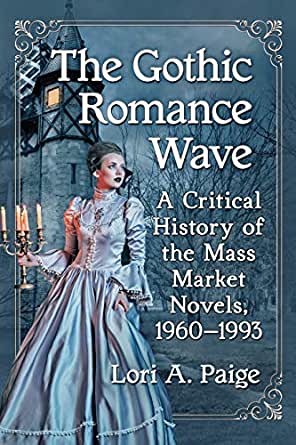
Gothic romances can be as addictive as crack. Artisans of the genre know what elements appeal to their audience and they deliver them in abundance. You like beautiful people conspiring in spooky mansions? We’ll publish that—times a thousand!!! Some snobs call this selling out, but I think it’s smart business to give fans what they want. A shame that this drug seems to have worn off, but there’s evidence, I hope, of a resurgence. Or, as this book concludes, maybe gothic romances never left. Not really.
While “Gothic Literature” remains well-studied in academia, it’s still Frankenstein and Wuthering Heights that anybody seems to care about. Daphne du Maurier’s Rebecca, maybe. Few are interested in Dark Shadows or the multitudes of mass-market gothic novels published during the Nixon era—but we do exist! And Lori A. Paige leads the charge.
Through extensive research, Paige chronicles the origins of gothic literature and its appeal to audiences over time, from Ann Radcliffe to penny dreadfuls to bodice rippers, but she spends most of her time dissecting how all this relates to the gothic boom of the 1960s and ’70s. The book’s title suggests 1993 as the end date to the gothic era, but that is rather generous. She admits that by 1980, mass-market gothics were already dismissed as nostalgia, and nobody, then or ever, has equated these fast-paced, grocery store titles as works of great art.
This vast dismissal is something she challenges quite effectively, and she points to several great novels as examples. She’s also willing to discuss questionable publishing tactics during that time, however, which resulted in many terrible novels and sketchy advertising. Such as rebranding old mysteries as “gothic” and using essentially the same cover art on thousands of titles. Even the cheap binding suggested these books weren’t meant for posterity. The vast majority were short and cheaply printed, so readers could afford them easily, consume them quickly, and buy more.
Paige acknowledges that most gothics were formulaic—usually a retelling of Jane Eyre or Rebecca—and muses over why audiences demanded this. It’s not just that writers were tasked to churn out these books at a lightning pace. Readers became furious if the basic gothic ingredients were changed too much. It’s a fascinating observation and something I’ve even noticed in my own reading habits. When the craving comes for a soap opera drama within a spooky dwelling—and it comes often—I find the nearest book on my shelf with a woman in a flowing dress fleeing eerie architecture. If the story inside doesn’t match up with those expectations, or tries too hard to jazz up the formula, I become annoyed.
Why? I truly don’t know, but it’s why I compare these novels to drugs. Something about the conflict to atmosphere ratio, with a pinch of sexual subtext, is an intoxicating combination that just works. It’s not great art and I know this, but it’s entertaining as hell.
Some gothic romance critics go beyond the weak prose and formulaic plots and call the novels anti-feminist. Paige vehemently disagrees and provides substantial evidence to the contrary. I agree with her assessment and have found many of these titles highly feministic in nature, even by today’s standards. Paige notes tongue-in-cheekily that most of these negative opinions of romance literature are either by men or women who’ve never read them.
As for their lasting influence, often she refers to the gothic wave as a collective cultural experience. Outside of the Dark Shadows TV show and its accompanied paperbacks, no single gothic book rose to significance during that era. Some authors were more popular than others, but their bibliographies include no classics or stand-out titles. Most readers didn’t care about authors much anyway. As long as the book had a recognizable cover, they knew they’d get the experience they wanted.
It’s this collected reading of dozens—if not hundreds—of these books that changed the literary landscape and paved the way for Stephen King’s more masculine horror and Kathleen Woodiwiss’ bestselling The Flame and the Flower, which is accredited as the first “bodice ripper.” Paige argues that elements of the gothic romance wave have rippled across all genres of literature, and not just the obvious ones like Twilight and Fifty Shades.
I agree. Though it’s no longer in vogue to write these concentrated doses of macabre soap opera, modern writers—consciously or unconsciously—have learned a lot about atmosphere and the journey of a heroine by the lasting impact of a decade of gothic romances ruling the publishing world.
Overall, Lori Paige’s academic investigations into this cobweb-ridden side of literature is nearly as entertaining as the books themselves. Be warned that she name drops a large list of intriguing titles that will have you searching eBay with one hand as you read with the other. It is my hope that more and more modern readers, including those in literary academia, will dust off these old paperbacks and give them a try, Assuming they can still find copies. I’ve heard that even places like Goodwill throw away donations of these books because of their age and poor condition. Hardly any have been republished as eBooks. Without renewed interest, I fear these books will have all but disappeared. Thank you Lori Paige for such a thorough undertaking that not only analyzes an under-studied side of publishing history, but also give us a reason to keep these forgotten books alive.

Thank you so much for your wonderful reviews. I greatly enjoyed reading this review, and all the others I’ve had the pleasure of reading. I have just added this book to my Christmas list. Keep up the great work!!